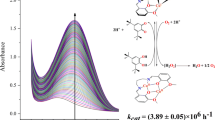Abstract
A series of model complexes for the diamagnetic type III site in multicopper oxidases has been developed based on tridentate ligands formed from the Schiff base condensation of bifunctional primary amines with the monoximes ofβ-diketones. The complexes resulting when copper salts, CuX2, react with the resulting ligands, HL, have the general formula Cu2L2X2 and have a central core made up of the two copper atoms bridged by two oxime groups resulting in a six-membered Cu(ON)2Cu moiety. This grouping is strictly planar and has significant shortening of the N-O bond length along with lengthening of the C=N bond indicating a delocalization of theπ-electrons in the ring. The result is a copper(II) dimer which is diamagnetic at all measurable temperatures (< 400 K). Spectroscopic, magnetic and electrochemical properties of the series of compounds will be compared with those of the parent enzyme containing the type III dicopper site. A second series of model complexes for both the type III site and the newly reported structure of the joint type II and type III site in ascorbate oxidase (crystal structure reported at the 3rd International Conference on Bioinorganic Chemistry, Boston, Mass, July 24–28, 1989) is also discussed. These compounds are obtained when ligands, H3L, resulting from the condensation of derivatives of salicylaldehyde with 1,3-diamino-2-propanol, are reacted with copper carboxylates resulting in compounds of formula Cu2L (carb). The carboxylate bridging group can be displaced by other better donors, L’, such as pyrazole, or indoles to give compounds (Cu2LL’)+ which have bridging L’ groups. The properties of this series of compounds will be compared with those of the type III site. If the L’ ligand is suitably derivatized, i.e. 6-aminoindole, then by a Schiff base condensation with copper salicylaldehyde, compounds of formula (Cu2LL’)2Cu(sal)2 can be obtained, which are models for multicopper oxidases having both the type II and type III sites in the same molecule, as has been found in the recent crystal structure of ascorbate oxidase. Comparisons between these models and multicopper oxidases will be drawn.
Similar content being viewed by others
Author information
Authors and Affiliations
Rights and permissions
About this article
Cite this article
Butcher, R.J., Sinn, E. & Mockler, G.M. Model compounds for the type III site and the combined type II and type III sites in multicopper oxidases. Proc. Indian Acad. Sci. (Chem. Sci.) 102, 209–218 (1990). https://doi.org/10.1007/BF02841935
Issue Date:
DOI: https://doi.org/10.1007/BF02841935




